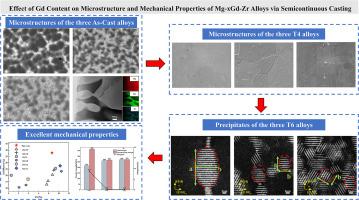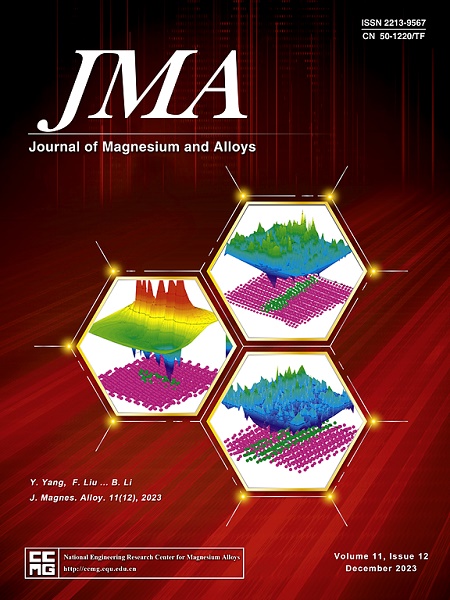Effect of Gd content on microstructure and mechanical properties of Mg-xGd-Zr alloys via semicontinuous casting
IF 15.8
1区 材料科学
Q1 METALLURGY & METALLURGICAL ENGINEERING
引用次数: 0
Abstract
Mg-Gd based alloys are an important class of high-performance Mg alloys. In this study, three Mg-Gd alloys with different gadolinium (Gd) contents: Mg-9.54Gd-0.40Zr (wt.%, G10 K), Mg-15.11Gd-0.35Zr (wt.%, G15 K) and Mg-19.67Gd-0.33Zr (wt.%, G20 K) were prepared by semicontinuous casting and subsequent solution and aging heat treatments. The role of Gd content on microstructures and mechanical properties of the Mg-Gd-Zr alloy is studied. All three as-cast alloys exhibit eutectic phases of Mg5Gd, with the amount increasing as the Gd content rises. Mg5Gd disappears after the solution heat treatment (the G10 K alloy solution-treated at 480 °C for 4 h, the G15 K alloy at 500 °C for 12 h and the G20 K alloy at 520 °C for 24 h, respectively). Aging heat treatment at 200 °C for 64 h after solution introduces numerous prismatic β′ precipitates, with a significant increase in their area number density corresponding to increased Gd content. Additionally, the morphology of the β′ precipitates exhibits distinct variations: the G10 K alloy is characterized by an enhanced aspect ratio. Consequently, the peak-aged G10 K alloy demonstrates superior strength-ductility synergy, with a yield strength (YS) of 216 ± 1 MPa, an ultimate tensile strength (UTS) of 363 ± 1 MPa, and an elongation (EL) of 8.7 ± 0.6 %. This study suggests that plasticity diminishes and precipitation strengthening is limited when the gadolinium content exceeds 15 wt.%.

钆含量对半连续铸造 Mg-xGd-Zr 合金微观结构和机械性能的影响
镁钆基合金是一类重要的高性能镁合金。本研究采用了三种不同钆(Gd)含量的镁钆合金:通过半连续铸造以及随后的固溶和时效热处理,制备了三种不同钆(Gd)含量的镁钆合金:Mg-9.54Gd-0.40Zr(重量百分比,G10 K)、Mg-15.11Gd-0.35Zr(重量百分比,G15 K)和 Mg-19.67Gd-0.33Zr(重量百分比,G20 K)。研究了钆含量对 Mg-Gd-Zr 合金微观结构和机械性能的影响。所有三种铸造合金都呈现出 Mg5Gd 共晶相,且随着 Gd 含量的增加而增加。Mg5Gd 在固溶热处理后消失(G10 K 合金分别在 480 ℃ 固溶处理 4 小时,G15 K 合金在 500 ℃ 固溶处理 12 小时,G20 K 合金在 520 ℃ 固溶处理 24 小时)。固溶后在 200 °C 下进行 64 小时的时效热处理会产生大量棱柱形 β′ 沉淀,其面积数密度会随着钆含量的增加而显著增加。此外,β′沉淀的形态也有明显的变化:G10 K 合金的特征是长宽比增大。因此,峰值时效 G10 K 合金显示出卓越的强度-电导率协同作用,屈服强度(YS)为 216 ± 1 MPa,极限拉伸强度(UTS)为 363 ± 1 MPa,伸长率(EL)为 8.7 ± 0.6 %。这项研究表明,当钆含量超过 15 wt.% 时,塑性减弱,沉淀强化受到限制。
本文章由计算机程序翻译,如有差异,请以英文原文为准。
求助全文
约1分钟内获得全文
求助全文
来源期刊

Journal of Magnesium and Alloys
Engineering-Mechanics of Materials
CiteScore
20.20
自引率
14.80%
发文量
52
审稿时长
59 days
期刊介绍:
The Journal of Magnesium and Alloys serves as a global platform for both theoretical and experimental studies in magnesium science and engineering. It welcomes submissions investigating various scientific and engineering factors impacting the metallurgy, processing, microstructure, properties, and applications of magnesium and alloys. The journal covers all aspects of magnesium and alloy research, including raw materials, alloy casting, extrusion and deformation, corrosion and surface treatment, joining and machining, simulation and modeling, microstructure evolution and mechanical properties, new alloy development, magnesium-based composites, bio-materials and energy materials, applications, and recycling.
 求助内容:
求助内容: 应助结果提醒方式:
应助结果提醒方式:


